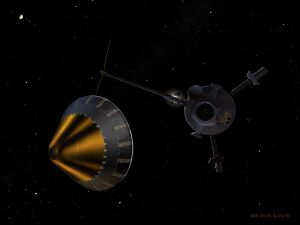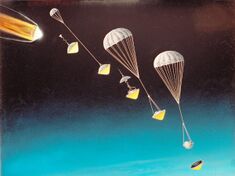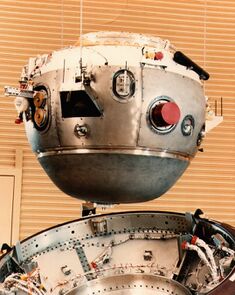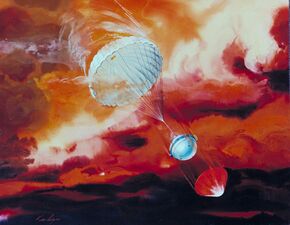Astronomy:Galileo Probe
 Illustration of Galileo Probe release from carrier | |
| Mission type | Lander / Atmospheric probe |
|---|---|
| Operator | NASA |
| COSPAR ID | 1989-084E[1] |
| Spacecraft properties | |
| Manufacturer | Hughes Aircraft Company |
| BOL mass | 339 kg (747 lb) |
| Start of mission | |
| Launch date | October 18, 1989 |
| Rocket | STS-34 piggybacking with Galileo orbiter |
The Galileo Probe was an atmospheric-entry probe carried by the main Galileo spacecraft to Jupiter, where it directly entered a hot spot and returned data from the planet.[2] The 339-kilogram (747 lb) probe was built by Hughes Aircraft Company[3] at its El Segundo, California plant, and measured about 1.3 meters (4.3 ft) across. Inside the probe's heat shield, the scientific instruments were protected from extreme heat and pressure during its high-speed journey into the Jovian atmosphere, entering at 47.8 kilometers (29.7 mi) per second. It entered Jupiter on December 7, 1995, 22:04 UTC and stopped functioning at 23:01 UTC, 57 minutes and 36 seconds later.[citation needed]
Mission
The probe was released from the main spacecraft in July 1995, five months before reaching Jupiter, and entered Jupiter's atmosphere with no braking beforehand. The probe was slowed from its arrival speed of about 47 kilometers per second to subsonic speed in less than two minutes. The rapid flight through the atmosphere heated the heat shield to around 15,500 °C (28,000 °F).[4]
At the time, this was by far the most difficult atmospheric entry ever attempted; the probe entered at Mach 50 and had to withstand a peak deceleration of 228 g.[5][6] The probe's 152 kg heat shield, making up almost half of the probe's total mass, lost 80 kg during the entry.[7][8] NASA built a special laboratory, the Giant Planet Facility, to simulate the heat load, which was similar to the convective heating experienced by an ICBM warhead reentering the atmosphere combined with the radiative heating of a thermonuclear fireball.[9][10][clarification needed] It then deployed its 2.5-meter (8.2-foot) parachute, and dropped its heat shield, which fell into Jupiter's interior.
As the probe descended through 156 kilometers (97 mi)[2] of the top layers of the Jovian atmosphere, it collected 58 minutes of data on the local weather. It only stopped transmitting when the ambient pressure exceeded 23 atmospheres and the temperature reached 153 °C (307 °F).[11] The data was sent to the spacecraft overhead, then transmitted back to Earth. Each of 2 L-band transmitters operated at 128 bytes per second and sent nearly identical streams of scientific data to the orbiter. All the probe's electronics were powered by lithium sulfur dioxide (LiSO2) batteries that provided a nominal power output of about 580 watts with an estimated capacity of about 21 ampere-hours on arrival at Jupiter.
Scientific instruments
The probe included seven instruments for taking data on its plunge into Jupiter:[12]
- an atmospheric structure instrument measuring temperature, pressure and deceleration,
- a neutral mass spectrometer,
- a Helium Abundance Detector, an interferometer supporting atmospheric composition studies,
- a nephelometer for cloud location and cloud-particle observations,
- a net-flux radiometer measuring the difference between upward and downward radiant flux at each altitude, and
- a lightning and radio emission instrument measuring light and radio emissions associated with lightning
- an energetic particle detector measuring energetic particles in Jupiter's radiation belts.
In addition, the probe's heat shield contained instrumentation to measure ablation during descent.[13] Total data returned from the probe was about 3.5 megabits (~460,000 bytes). The probe stopped transmitting before the line of sight link with the orbiter was cut.[further explanation needed] The likely proximal cause of the final probe failure was overheating, which sensors indicated before signal loss.
The probe transmitted data down to 21 bars of pressure.[14] (Earth sea-level is about 1 bar of pressure)
Results and end
The probe entered Jupiter's atmosphere at 22:04 UTC.[15] Before the atmospheric entry, the probe discovered a new radiation belt 31,000 miles (50,000 km) above Jupiter's cloud tops. The atmosphere through which it subsequently descended was found to be much denser and hotter than expected. Jupiter was also found to have only half the amount of helium expected and the data did not support the three-layered cloud structure theory. Only one significant cloud layer was measured by the probe, but with many indications of smaller areas of increased particle densities along all of the trajectory.[16] The probe detected less lightning, less water, but more winds than expected. The atmosphere was more turbulent and the winds a lot stronger than the expected maximum of 350 kilometers per hour (220 mph). It required a laborious analysis of the initial wind data from the probe to determine the actual measured wind speeds. The results eventually showed that wind speeds in the outermost layers were 290-360 kilometers per hour (80–100 m/s), in agreement with previous measurements from afar, but that winds increased dramatically at pressure levels of 1-4 bars, then remaining consistently high at around 610 kilometers per hour (170 m/s).[17] No solid surface was detected during the 156-kilometer (97 mi) downward journey.[2] Subsequent analysis determined that the Galileo probe had entered a so-called hot spot in Jupiter's atmosphere.
Radio contact ceased (due to the high temperature) 78 minutes after entering Jupiter's atmosphere at a depth of 160 kilometers.[citation needed] At that point the probe measured a pressure of 22 bars and a temperature of 152 °C.[18] Theoretical analysis indicates that the parachute would have melted first, roughly 105 minutes after entry, then the aluminum components after another 40 minutes of free fall through a sea of supercritical fluid hydrogen. The titanium structure would have lasted around 6.5 hours more before disintegrating. Due to the high pressure, the droplets of metals from the probe would finally have vaporized once their critical temperature had been reached, and mixed with Jupiter's liquid metallic hydrogen interior.[19] The probe was expected to have completely vaporized 10 hours after its atmospheric entry.[15]
Artist's impression of the probe's entry into Jupiter's atmosphere
Diagram of the atmospheric entry probe's instruments and subsystems
Over time it was possible to mine the data for further insights into the atmosphere, and one way to do this was to study the motion of the probe during the descent down.[14] It was found that at 700 mbar of pressure the winds on Jupiter are prograde and increase to a speed of 170 m/s at 4000 mbars of pressure.[14]
Names
Galileo Probe has cospar ID 1989-084E while the orbiter had id 1989-084B.[20] Names for the spacecraft include Galileo Probe or Jupiter Entry Probe abbreviated JEP.[21][22]
The related COSPAR IDs of the Galileo mission:[23]
- 1989-084A STS 34
- 1989-084B Galileo
- 1989-084C IUS (Orbus 21)
- 1989-084D IUS (Orbus 6E)
- 1989-084E Galileo Probe
See also
- List of spacecraft powered by non-rechargeable batteries
- Pioneer Venus Multiprobe
- Huygens spacecraft (carried by Cassini orbiter to Saturn's moon Titan)
- Saturn Atmospheric Entry Probe (concept for similar spacecraft entry probe for Saturn)
References
- ↑ Badescu, Viorel; Zacny, Kris (2018-04-28). Outer Solar System: Prospective Energy and Material Resources. ISBN 9783319738451. https://books.google.com/?id=vvhYDwAAQBAJ&pg=PA836&lpg=PA836&dq=1989-084E#v=onepage&q=1989-084E&f=false.
- ↑ 2.0 2.1 2.2 "Galileo Probe Science Results". JPL. 22 January 1996. http://www2.jpl.nasa.gov/sl9/gll38.html. Retrieved 4 March 2016.
- ↑ "Hughes Science/Scope Press Release and Advertisement, retrieved from Flight Global Archives May 23, 2010". flightglobal.com. http://www.flightglobal.com/pdfarchive/view/1989/1989%20-%200347.html. Retrieved 2011-05-15.
- ↑ http://www.spaceanswers.com/space-exploration/the-probe-that-survived-for-78-minutes-inside-jupiter/
- ↑ Heppenheimer, Thomas A. (2009). Facing the Heat Barrier: A History of Hypersonics. Government Printing Office. ISBN 978-0160831553. https://books.google.com/books?id=dUXKgSYZPV8C&pg=PA257&dq=Galileo+Probe+mach+50.
- ↑ Chu-Thielbar (2007-07-19). "Probing Planets: Can You Get There From Here?". http://www.space.com/searchforlife/070719_seti_probing.html. Retrieved 2007-07-27.
- ↑ Julio Magalhães (1997-09-17). "Galileo Probe Heat Shield Ablation". NASA Ames Research Center. http://spaceprojects.arc.nasa.gov/Space_Projects/galileo_probe/htmls/Heat_Shield.html.
- ↑ Julio Magalhães (1996-12-06). "The Galileo Probe Spacecraft". NASA Ames Research Center. http://spaceprojects.arc.nasa.gov/Space_Projects/galileo_probe/htmls/probe_spacecraft.html.
- ↑ Laub, B.; Venkatapathy, E. (6–9 October 2003). "Thermal Protection System Technology and Facility Needs for Demanding Future Planetary Missions". International Workshop on Planetary Probe Atmospheric Entry and Descent Trajectory Analysis and Science. Lisbon, Portugal. http://www.mrc.uidaho.edu/entryws/presentations/Papers/laub_tps.pdf. Retrieved 2006-12-12.
- ↑ Bernard Laub (2004-10-19). "Development of New Ablative Thermal Protection Systems (TPS)". NASA Ames Research Center. http://asm.arc.nasa.gov/full_text.html?type=materials&id=1.
- ↑ "Galileo Mission to Jupiter, NASA". .jpl.nasa.gov. http://www2.jpl.nasa.gov/galileo/mission/journey-arrival.html. Retrieved 2011-05-15.
- ↑ Galileo Probe NASA Space Science Data Coordinated Archive
- ↑ Milos, Frank S. (1997). "Galileo Probe Heat Shield Ablation Experiment". Journal of Spacecraft and Rockets 34 (6): 705–713. doi:10.2514/2.3293. Bibcode: 1997JSpRo..34..705M. https://zenodo.org/record/1235941.
- ↑ 14.0 14.1 14.2 Atkinson, David H.; Pollack, James B.; Seiff, Alvin (1998-09-01). "The Galileo Probe Doppler Wind Experiment: Measurement of the deep zonal winds on Jupiter" (in en). Journal of Geophysical Research: Planets 103 (E10): 22911–22928. doi:10.1029/98je00060. ISSN 0148-0227. Bibcode: 1998JGR...10322911A.
- ↑ 15.0 15.1 Galileo Probe Entry Timeline NASA
- ↑ Ragent, B; Colburn, DS; Avrin, P; Rages, KA (1996). "Results of the Galileo probe nephelometer experiment". Science 272 (5263): 854–6. doi:10.1126/science.272.5263.854. PMID 8629019. Bibcode: 1996Sci...272..854R.
- ↑ Atkinson, David H.; Ingersoll, Andrew P.; Seiff, Alvin (1997). "Deep winds on Jupiter as measured by the Galileo probe". Nature 388 (6643): 649–650. doi:10.1038/41718. Bibcode: 1997Natur.388..649A.
- ↑ Galileo Probe Mission Events
- ↑ Jonathan McDowell (1995-12-08). "Jonathan's Space Report, No. 267". Harvard-Smithsonian Center for Astrophysics. http://www.planet4589.org/space/jsr/back/news.267.
- ↑ Badescu, Viorel; Zacny, Kris (2018-04-28) (in en). Outer Solar System: Prospective Energy and Material Resources. Springer. ISBN 9783319738451. https://books.google.com/?id=vvhYDwAAQBAJ&pg=PA836&lpg=PA836&dq=1989-084E#v=onepage&q=1989-084E&f=false.
- ↑ Ritter, H.; Mazoue, F.; Santovincenzo, A.; Atzei, A. (2006). "Jupiter Entry Probe Feasibility Study from the ESTEC CDF Team: Heat Flux Evaluation & TPS Definition". Thermal Protection Systems and Hot Structures 631: 6. Bibcode: 2006ESASP.631E...6R.
- ↑ Atkinson, David H.; Pollack, James B.; Seiff, Alvin (1998-09-01). "The Galileo Probe Doppler Wind Experiment: Measurement of the deep zonal winds on Jupiter" (in en). Journal of Geophysical Research: Planets 103 (E10): 22911–22928. doi:10.1029/98je00060. ISSN 0148-0227.
- ↑ "Space Launch 1989-084". https://www.lib.cas.cz/space.40/1989/084.HTM.
Sources
- Galileo Probe NASA Space Science Data Coordinated Archive
External links







